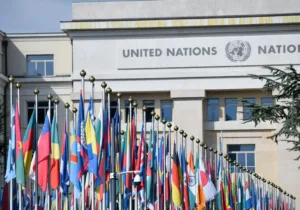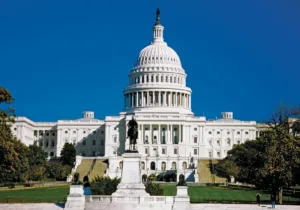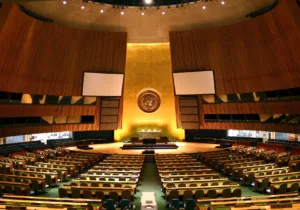It would appear the ghost of James Madison has been roaming the corridors of the US Department of State in recent weeks. The topic to which this particular Founding Father devoted a lifetime—religious freedom—has also been a high priority of late for residents of Foggy Bottom.
In the closing days of July, Secretary of State Mike Pompeo played host to hundreds of human rights activists, foreign government officials, religious leaders, and NGO representatives from more than 80 nations at the first-ever Ministerial to Advance Religious Freedom. At the conclusion of this landmark gathering, Secretary Pompeo introduced the Potomac Declaration, a formal statement reaffirming the United States’ commitment to international religious freedom (IRF). Like thoughtful and well-meaning declarations before it, the Potomac Declaration proclaims the inviolability of religious freedom and the importance of preserving and protecting this most fundamental of all human rights.
Yet a quick glance in the historical rearview mirror, beginning with Madison, makes one wonder, how many declarations does it take to secure religious freedom?
In May 1776, Madison set a high bar for the protection of religious liberty. As lawmakers for the newly formed Commonwealth of Virginia wrestled with the semantics of a new constitution, Madison pressed for more than mere “toleration” of religion. He understood matters of faith and conscience to be granted not by governments but as preceding governments. In a word, inalienable. Madison prevailed; thus, the Virginia Declaration of Rights includes Article 16, which states:
Religion, or the duty which we owe to our creator and the manner of discharging it, can be directed only by reason and conviction, not by force or violence; and therefore, all men are equally entitled to the free exercise of religion, according to the dictates of conscience; and that it is the mutual duty of all to practice Christian forbearance, love, and charity towards each other. (emphasis added)
More than a few of Madison’s contemporaries shared his sensibilities, not the least of whom was fellow-Virginian Thomas Jefferson. A few weeks after the Virginia Declaration was unanimously approved, Jefferson incorporated similar language into the American Declaration of Independence:
We hold these truths to be self-evident, that all men are created equal, that they are endowed by their Creator with certain unalienable rights, that among these are Life, Liberty and the pursuit of Happiness.
The influence of Madison on religious freedom continued in his role as architect of the first ten amendments to the newly minted US Constitution. The Bill of Rights was reminiscent of and strongly influenced by the Virginia Declaration. Madison’s resolve and persistence guaranteed that religious freedom would remain enshrined as the first freedom: “Congress shall make no law respecting an establishment of religion, or prohibiting the free exercise thereof.”
Madison and company succeeded in creating a unique system whereby religion was protected but not central to the functions of government. Of course, if men were angels, these early attempts at codifying religious freedom might have been sufficient. Yet, while religious freedom remains foundational to the American character and serves as a healthy (if imperfect) model for the international community, human nature often gets in the way. Fast-forward to the twentieth century and more declarations abound.
In the aftermath of World War II and the human rights atrocities meted out on millions of innocent civilians, the newly formed United Nations drafted and approved the Universal Declaration of Human Rights (UDHR) in 1948. Signed by 48 member nations, Article 18 focuses narrowly on the guarantee of religious freedom:
Everyone has the right to freedom of thought, conscience and religion; this right includes freedom to change his religion or belief, and freedom, either alone or in community with others and in public or private, to manifest his religion or belief in teaching, practice, worship and observance.
Since 1948, UDHR language has been embedded in numerous international treaties, national constitutions, and laws. Its significance as a transformative and unifying statement for the international community has been critical, yet insufficient. The Helsinki Final Act followed UDHR more than 25 years later, and while this act was not originally pursued as a human rights initiative, it proved to be a potent remedy to some of the Cold War’s most widespread humanitarian abuses. Principle VII stated:
The participating States will respect human rights and fundamental freedoms, including the freedom of thought, conscience, religion or belief, for all without distinction to race, sex, language or religion.
Next came the International Religious Freedom Act (IRFA), which Congress passed 20 years ago and underscored America’s centuries-old commitment to freedom of religion. IRFA secured the importance of religious freedom as part of US foreign policy.
So after centuries of declarations upholding the importance of and commitment to religious freedom, why are we still issuing declarations? What more can be said? What nuanced language can be added?
Perhaps the answer lies with each generation. Each generation must hold dear the importance of religious freedom and reaffirm the need to protect and nurture it, lest tyrants trample it.
At the Ministerial to Advance Religious Freedom, US Ambassador-at-Large for Religious Freedom Sam Brownback spoke of the broad impact religious freedom can have, saying that “we believe this is such a foundational right it will really help in other places if we can get this one right.”
Brownback spoke to the participants of forging a global alliance for the twenty-first century: “Together—an alliance of government, civil society, and faith—we can and will advance religious freedom. With your engagement and leadership, we know the promotion of this universal human right will happen. Let’s get it done.”
The Potomac Declaration has much in common with preceding statements. What is fresh is the accompanying Potomac Action Plan, which Secretary Pompeo announced.
“The Potomac Declaration is a formal affirmation that says right up front that the United States takes religious freedom seriously, that we will work with others around the world to help those under attack for their beliefs, and that we expect leaders around the world to make it their priority as well,” Pompeo said in his closing remarks. “The plan of action provides concrete ways the international community and governments can do more to protect religious freedom and to protect vulnerable religious communities in their own countries.”
On the topic of religious freedom, James Madison would likely agree that actions speak louder than words. The Potomac Action Plan may provide the tangible steps required for advancing religious freedom in this generation. Greg Mitchell, co-founder of the International Religious Freedom Roundtable, an informal group of individuals and non-governmental organizations that meets regularly to discuss IRF issues, believes that success in the wake of the IRF Ministerial comes down to follow through.
“If we don’t follow through, we won’t change anything. In fact, we could do more harm than good,” says Mitchell, while applauding the Ministerial’s great success. He also believes if the Trump administration does not start putting pressure on governments that violate religious freedom, particularly those governments that attended the week-long events, “they are going to think this was all for show, and they will keep restricting religious freedom.”
The IRF Roundtable will hold a Ministerial debriefing meeting on Capitol Hill August 7 to analyze the Potomac Plan of Action’s key points. “We already have plenty of language out there,” notes Mitchell. “I’m focused on the Plan of Action and how we can use it to actually make things happen.
If you would like to attend the IRF Roundtable debriefing or would like additional information, contact IRF Roundtable here.
—
Erin Rodewald is a Los Angeles-based strategist, writer, researcher, and editor specializing in foreign policy, international relations, and American politics. With more than 20 years of communication experience, she has served as the press secretary for the president of the Los Angeles City Council and has provided strategic public relations council for public affairs, business-to-business and high-tech clients. Erin served on the team that organized and executed the international events and initiatives commemorating the Ronald Reagan Centennial Celebration. She is the co-owner of a high tech public relations firm and holds an MPP from Pepperdine University. Follow Erin on Twitter @EDRodewald.
Photo Credit: Ambassador at Large for International Religious Freedom Sam Brownback introduces Jared Kushner, director of the Office of American Innovation, at the working luncheon for the Ministerial to Advance Religious Freedom on July 26, 2018 at the US Department of State, in Washington, DC. State Department Photo.






